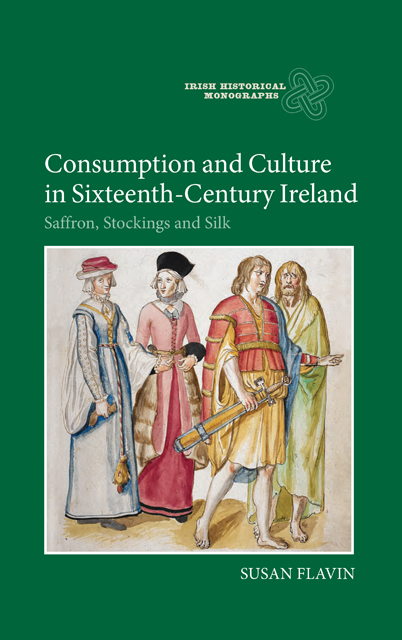5 - Wearing, Making and Embellishing
Published online by Cambridge University Press: 24 February 2023
Summary
Clothing in context
Notably absent amongst Irish imports are ready-made outerwear garments such as gowns, doublets, cloaks and breeches. Throughout the accounts examined, there are in fact only four occurrences of such items; in 1550, John Fleatt imported 100 petticoats; in 1575, a Kilkenny merchant, Martin Archer, imported 4 leather jerkins, and in the same year, George Purkell, a London merchant, imported 12 sack cloth and 12 canvas doublets. It may be the case that these imported items were banned in this region, as they had been in Dublin in 1555 when the tailors, shoemakers and other tradesmen in the city felt so threatened by foreign imports that they banned the importation of ready-made hose, doublets, trews, jerkins, boots and shoes. As yet, there is no evidence to suggest this, however. The near absence of such items may indicate a fundamental difference in tastes between Irish and English consumers, and a preference for domestically produced apparel, but it must of course be noted that very little clothing was sold ‘off the peg’ in any country in the sixteenth century, with most households purchasing cloth and either making up clothing themselves or getting a tailor to do so.
Analysis of costumes recovered from bogs shows that there were at least three different gown styles worn in sixteenth-century Ireland. These have been considered in detail by Dunlevy, who noted distinct differences between English and Irish styles and argued that Irish fashion as a separate and distinctive entity continued to evolve in the sixteenth century; the Irish incorporated and adapted selected aspects of foreign styles into their costume as the century progressed. A particular style of gown worn by Irish women had ‘a distinctively Irish strip of fabric which covers the top of the arm from each shoulder and which is anchored at the waist with a cuff or tie band’. These, visible on the picture by de Heere (Plate 8), were described by Spenser as ‘hanging’ sleeves and appear to be unique to Irish dress. Also notable is a gown found in a bog in County Tipperary, which shows similarities to the Spanish Ropa or to the Dutch Vlieger and indicates the awareness of continental dress changes in Ireland.
- Type
- Chapter
- Information
- Consumption and Culture in Sixteenth-Century IrelandSaffron, Stockings and Silk, pp. 96 - 117Publisher: Boydell & BrewerPrint publication year: 2014



